
The Devil Strikes at Night is a 1957 West German crime thriller film directed by Robert Siodmak and starring Claus Holm, Mario Adorf and Hannes Messemer. The film noir is based on the true story of Bruno Lüdke. It was shot at the Baldham Studios. The film's sets were designed by the art directors Gottfried Will and Rolf Zehetbauer. Location shooting took place in Berlin and Munich. It was nominated for the Academy Award for Best Foreign Language Film, as well as winning German Film Award for Best Fiction Film in its native country.
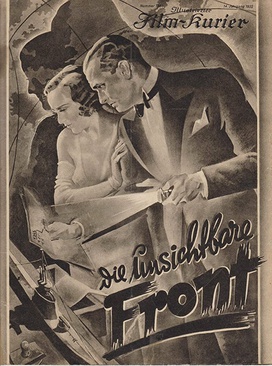
The Invisible Front is a 1932 German spy thriller film directed by Richard Eichberg and starring Trude von Molo, Karl Ludwig Diehl, Veit Harlan and Paul Hörbiger. The story was written by Robert A. Stemmle, Curt Siodmak and Max W. Kimmich, who also presented the idea of this film to his colleagues. It was made at the Johannisthal Studios in Berlin and on location in Hamburg. The film's sets were designed by the art directors Artur Günther and Willi Herrmann.
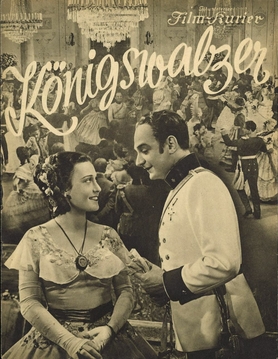
The Royal Waltz is a 1935 German musical film directed by Herbert Maisch and starring Paul Hörbiger, Curd Jürgens, and Carola Höhn. It was shot at the Babelsberg Studios of UFA in Berlin. The film's sets were designed by the art directors Robert Herlth and Walter Röhrig. A separate French-language version Royal Waltz was also released. It was remade in 1955 under the same title.

Tomfoolery is a 1936 German comedy film directed by Willi Forst and starring Renate Müller, Jenny Jugo and Anton Walbrook. It was shot at the Johannisthal Studios in Berlin. The film's sets were designed by the art directors Kurt Herlth and Werner Schlichting. It premiered at the Gloria-Palast in Berlin on 12 June 1936.

Gently My Songs Entreat is a 1933 Austrian-German musical film directed by Willi Forst and starring Marta Eggerth, Luise Ullrich and Hans Jaray. The film was shot at the Sievering Studios in Vienna with art direction by Julius von Borsody. The film is a biopic of the composer Franz Schubert (1797–1828). It was Forst's directorial debut. A British version was made called Unfinished Symphony. The German title refers to the first line of the Lied "Ständchen" (Serenade) from Schubert's collection Schwanengesang, "the most famous serenade in the world", which Eggerth performs in the film.

Operetta is a 1940 German musical film directed by Willi Forst and starring Forst, Maria Holst and Dora Komar. The film was made by Wien-Film, a Vienna-based company set up after Austria had been incorporated into Greater Germany following the 1938 Anschluss. It is the first film in director Willi Forst's "Viennese Trilogy" followed by Vienna Blood (1942) and Viennese Girls (1945). The film portrays the life of Franz Jauner (1832–1900), a leading musical figure in the city. It is both an operetta film and a Wiener Film.
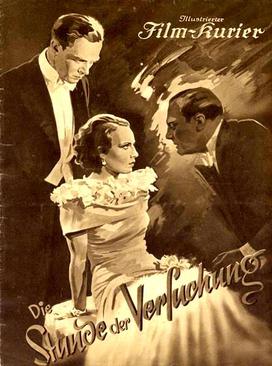
The Hour of Temptation is a 1936 German mystery film directed by Paul Wegener and starring Gustav Fröhlich, Lída Baarová and Harald Paulsen.

The Muzzle is a 1958 West German comedy film directed by Wolfgang Staudte and starring O.E. Hasse, Hertha Feiler and Hansjörg Felmy. It is a remake of the 1938 film of the same title.

My Heart Calls You is a 1934 German musical film directed by Carmine Gallone and starring Jan Kiepura, Mártha Eggerth and Paul Kemp. Separate English-language and French-language versions were made, both also directed by Gallone.
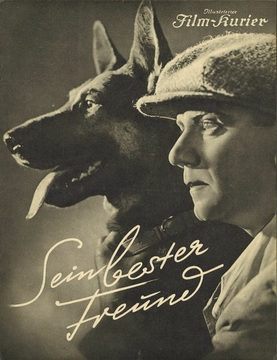
His Best Friend is a 1937 German crime film directed by and starring Harry Piel. It also features Edna Greyff, Henry Lorenzen and Lissy Arna. It was shot at the Johannisthal Studios in Berlin. The film's sets were designed by the art directors Karl Weber and Erich Zander. Piel had previously starred in a 1929 film of the same title.

Court Theatre is a 1936 Austrian drama film directed by Willi Forst and starring Werner Krauss, Carl Esmond and Hortense Raky.

The Appeal to Conscience is a 1949 German mystery film directed by Karl Anton and starring Karl Ludwig Diehl, Werner Hinz and Gustav Diessl. It was originally shot in 1944, but remained uncompleted until it was finished by DEFA in the post-war era. It remained unreleased until it was given a 1949 premiere in Austria. Subsequently it was distributed in East Germany in 1950 and West Germany in 1951.
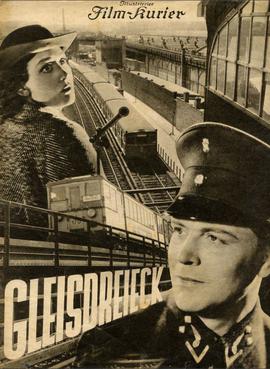
Dangerous Crossing or Rail Triangle is a 1937 German crime film directed by Robert A. Stemmle and starring Gustav Fröhlich, Heli Finkenzeller, and Paul Hoffmann. It is set amongst railway workers and takes its name from Gleisdreieck on the Berlin U-Bahn. It was partly shot at the Babelsberg Studios in Potsdam. The film's sets were designed by the art directors Carl Böhm and Erich Czerwonski. It was shot on location around Berlin. It premiered at the city's Ufa-Palast am Zoo.

The Tiger Murder Case is a 1930 German mystery film directed by Johannes Meyer and starring Charlotte Susa, Harry Frank and Hertha von Walther. It was shot at the Babelsberg Studios in Berlin. The film's sets were designed by the art director Willi Herrmann.
Alarm at Midnight or Help! Armed Assault! is a 1931 German thriller film directed by Johannes Meyer and starring Hans Stüwe, Hans Brausewetter, and Otto Wallburg.

The Merciful Lie is a 1939 German drama film directed by Werner Klingler and starring Hilde Krahl, Elisabeth Flickenschildt and Ernst von Klipstein. It was shot at the Johannisthal Studios in Berlin and on location in Bremen. The film's sets were designed by the art directors Karl Böhm and Erich Czerwonski.

Adventure in Vienna is a 1952 Austrian crime thriller film directed by Emil E. Reinert and starring Gustav Fröhlich, Cornell Borchers and Adrienne Gessner. It is an adaptation of the 1933 novel I Was Jack Mortimer by Alexander Lernet-Holenia. A separate English-language version Stolen Identity was also produced.

Police Report is a 1939 German crime thriller film directed by Rudolf van der Noss and starring Lola Müthel, Hans Zesch-Ballot and Erich Fiedler. It was shot at the Babelsberg Studios in Berlin. The film's sets were designed by the art directors Heinrich Beisenherz and Alfred Bütow. It was produced and distributed by Terra Film.

The Unexcused Hour is a 1937 Austrian comedy film directed by E.W. Emo and starring Anton Edthofer, Hans Moser and Dagny Servaes. It was shot at the Sievering Studios in Vienna. The film's sets were designed by the art director Fritz Maurischat. It was remade as a 1957 film of the same title directed by Willi Forst.


















